Understanding the Versatility and Importance of Liquid Level Sensors

Nowadays, in the complex industrial process, accurate measurement and control of liquid levels are crucial. Everything requires smooth working, whether it is environmental maintenance or taking care of appliances.
Why is it necessary? It allows for accurate prevention of the overflow of chemical reactors in storage tanks and optimization of water usage in irrigation systems. Also, liquid level sensors help determine the liquid level required within a container.
The liquid level sensor plays a vital role in liquid management systems, offering real-time data. This data enables adequate control, enhances safety, and prevents costly errors. The versatile stems of these sensors are connected to various technologies for specific applications. Let’s explore the liquid level sensors and their types to know more about this solution in detail.
What are Liquid Level Sensors?
A device used to detect and measure liquid levels within a tank or other container is recognized as a liquid level sensor. This measurement can be used constantly to get a precise reading of the liquid heights. It allows industry handlers to know the specific height, high or low, that a liquid reaches. These sensors gathered all the information and transferred it to a control system. Further, this transmission can initiate actions, including starting and stopping pumps, triggering alarms, and opening or closing valves.
Types of Liquid Level Sensors
Liquid level sensing deals with the richness of technological diversification. It combines both electronic and physical terms to achieve accurate and trustworthy measurements. Some of the common types of liquid level sensors are:
1. Float Switches: These switches are not only the simplest type of level sensor but also cost-effective. This system operates based on the principle of buoyancy. This magnet or mechanical build switch rises or falls with the liquid level. After reaching a determined point, it triggers the switch, showing a level indication. These switches are excessively used for point-level detection in applications ranging from sump pumps to high- and low-level alarms in tanks.
2. Capacitance Level Sensors: These sensors use the principle of capacitance, which is the ability of a system to store an electrical charge. They typically consist of two conductive plates separated by a dielectric material (the liquid and the surrounding air or vacuum). As the liquid level rises or falls, the amount of dielectric material between the plates changes, causing a corresponding change in capacitance. This change is then measured and correlated to the liquid level. Capacitance sensors are versatile and can be used for both conductive and non-conductive liquids.
3. Ultrasonic Level Sensors: 3. Ultrasonic Level Sensors:
These non-contact level sensors emit high-frequency sound waves, which then measure how long the echo takes to return after reflecting off the liquid surface. The distance to the liquid surface, thus the level, is measured using the speed of sound and the time it has travelled. Ultrasonic sensors are especially ideal in non-contact level measurement applications and in cases where there are corrosive or hazardous liquids, which make physical contact with the sensor undesirable.
4. Radar (Microwave) Level Sensors: Radar level sensors operate similarly to ultrasonic sensors except, as the name implies, they pulse electromagnetic waves, aka microwaves, rather than sound waves. Furthermore, microwaves can be affected by temperature, pressure, and also vapor in a much smaller way than sound waves, which means radar is used in more demanding applications, including those working with turbulence or harsher environmental conditions. Radar/ microwave sensors will provide good accuracy and reliable non-contact level measurement over longer distances.
5. Pressure Transducers: These sensors essentially measure the hydrostatic pressure applied by the liquid column to the bottom of the tank. The pressure exerted on the transducer is proportional to the height of the liquid column and its specific gravity. Therefore, pressure transducers provide a continuous level measurement and are often used for closed tank applications where the density of the liquid remains fairly constant.
6. Optical Level Sensors: Optical level sensors apply light to detect if a liquid is present or absent at a particular location. There are various types, however, typically, they are either prism-type sensors or fiber-optic sensors. Prism-type sensors usually depend on the change in refractive index when the liquid is present. The fiber optic sensor detects a change in light transmission or reflection. Optical sensors are common for point level switches, leak detection, and applications wherein size and response time are valued.
The benefits of employing liquid level sensors
are manifold and contribute significantly to operational efficiency, safety, and cost-effectiveness. Some key advantages include:
- Automation and Reduced Manual Intervention: Level sensors provide continuous or on-demand level readings, eliminating the need for manual gauging, which is often time-consuming, labor-intensive, and potentially hazardous.
- Improved Accuracy and Reliability: Electronic level sensors offer far greater accuracy and consistency compared to manual methods, leading to more precise control and reduced errors.
- Enhanced Safety: By providing timely alerts for high or low levels, sensors can prevent overflows, dry running of pumps, and other potentially dangerous situations.
- Optimized Inventory Management: Accurate level data allows for better tracking of liquid inventories, facilitating efficient procurement and reducing waste.
- Increased Process Efficiency: Precise level control enables smoother and more consistent industrial processes, leading to improved product quality and reduced downtime.
- Cost Savings: Automation, reduced errors, and optimized resource utilization translate into significant cost savings over time.
Conclusion
To sum up, liquid level sensors are essential in various applications, ensuring safe and efficient liquid management. With a range of available technologies, it’s possible to choose the right sensor based on liquid type, operating conditions, accuracy requirements, and budget. As industries embrace automation and digitalization, the significance of liquid level sensing technology will continue to grow, playing a crucial role in our advanced world.
What's Your Reaction?































































